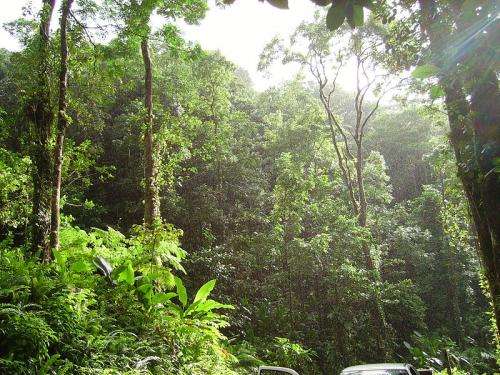September 23, 2016 report
Paper highlights the dismal state of dry forests in tropical regions in the Americas

(Phys.org)—A very large team of researchers from South America, Europe and the U.S. has published a paper in the journal Science highlighting plant diversity in neotropical dry forests in the Americas and arguing for more protection of such natural areas.
When most people think of forests in the tropics it is generally the rainy kind that come to mind—the might Amazon, for example, is known to people both in and outside of the scientific community. But, mostly ignored or forgotten, the researchers contend, are dry forests that exist in some of the same areas—dry forests that are disappearing at an alarming rate.
The researchers note that neotropical dry forests harbor plant species that exist nowhere else on Earth—recent work by members of the team has found large variations in plant species between dry forests which suggests each has a unique intrinsic value. They also conducted an analysis with a database the holds information on 4,660 species of woody plants in the dry forests and identified 12 major plant communities within the region. And alarmingly, they point out that only 10 percent of the forests present prior to humans arriving on the scene still remain today.
Humans going back to the Incas have been razing dry forests to gain access to the lush soil that offers prime agricultural opportunities. The researches point out that remaining forests exist in small pockets in many locations in North, South and Middle America and also on many Caribbean Islands. But their presence continues to shrink as very little of the land is protected. The researchers note that unlike the rain forests, very few people are aware of the damage that is being wrought and the loss that will occur if something is not done to prevent the disappearance of such forests altogether.
The team is hoping their paper will raise awareness of the plight of the dry forest in the Americas in the scientific community perhaps nudging more researchers to get involved in studying the forests and ways to protect them. They have also commissioned a short animated film that can be shown to non-scientists across the region to heighten awareness of the problem and to garner support for more conservation efforts.
More information: K. Banda-R et al. Plant diversity patterns in neotropical dry forests and their conservation implications, Science (2016). DOI: 10.1126/science.aaf5080
Abstract
Seasonally dry tropical forests are distributed across Latin America and the Caribbean and are highly threatened, with less than 10% of their original extent remaining in many countries. Using 835 inventories covering 4660 species of woody plants, we show marked floristic turnover among inventories and regions, which may be higher than in other neotropical biomes, such as savanna. Such high floristic turnover indicates that numerous conservation areas across many countries will be needed to protect the full diversity of tropical dry forests. Our results provide a scientific framework within which national decision-makers can contextualize the floristic significance of their dry forest at a regional and continental scale.
Journal information: Science
© 2016 Phys.org




















